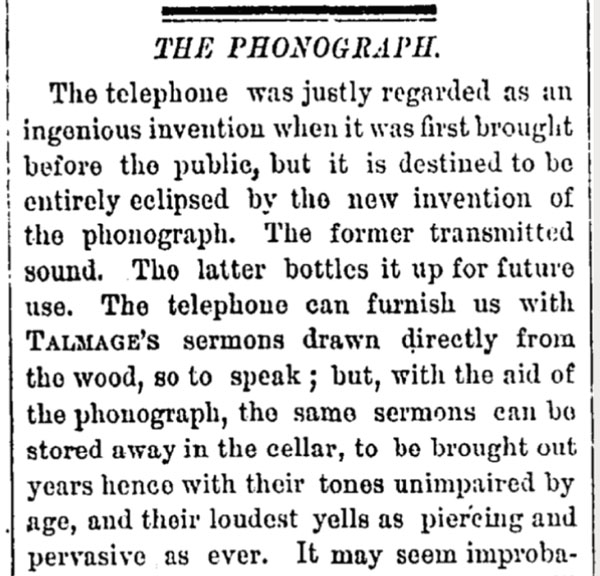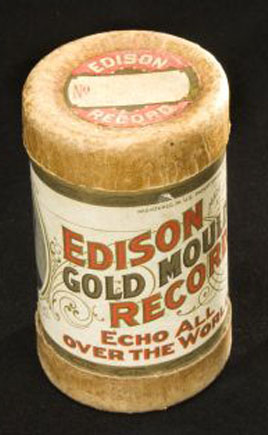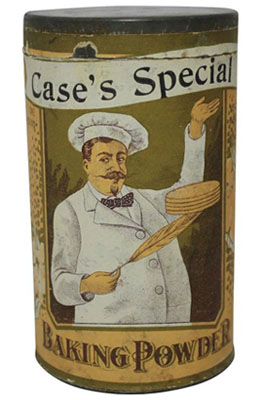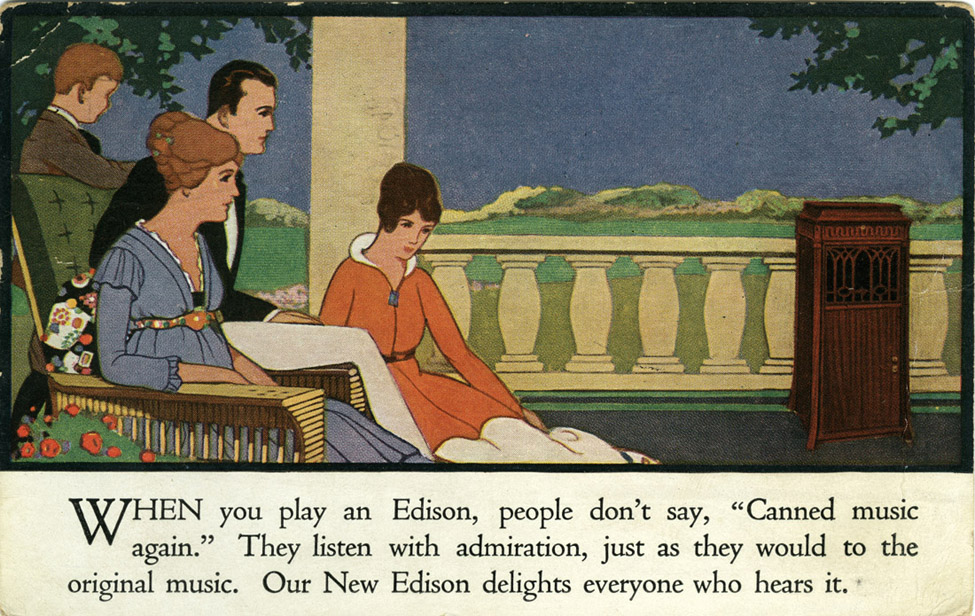Bottling
Up Sound for Future Use
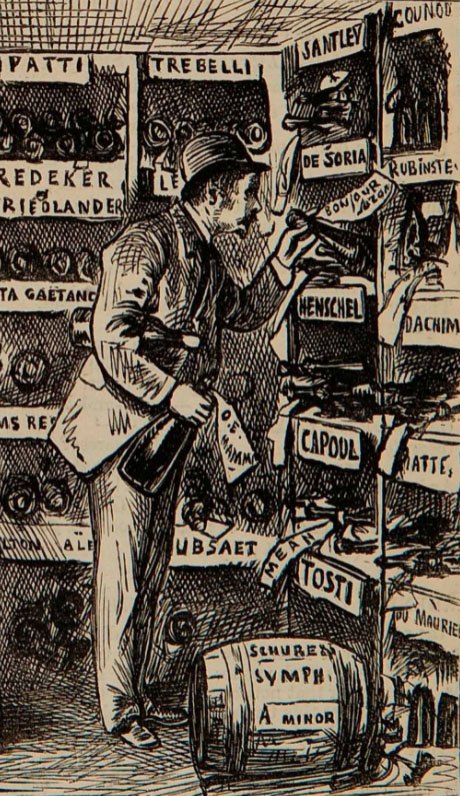
Punch’s Almanack
for 1878, December 14, 1877
By Doug Boilesen, 2020
The invention of the phonograph
would result in various ways the public could think about the
phonograph's fundamental and revolutionary ability to capture
sound for future use. The following are examples of some of
those metaphors and phrases that appeared in print to describe
the wonder of recorded sound, e.g., bottled sound, "canned
music," imprisoned sound, gathered up and retained sounds,
captured sound, etc.
Bottled
Sound
The New York Times
on November 7, 1877, responding to the announcement that Edison's
phonograph would soon be a reality, wrote an article starting with
the statement that the phonograph "was destined" to entirely
eclipse the ingenious telephone which only transmitted sound whereas
the phonograph "bottles it up for future use."
The New York Times
on November 7, 1877,
.
This article, however, was written
one month before Edison actually completed his phonograph and six
months before Edison would publish his own probabilities about the
future of the phonograph so enthusiasm, speculation and skepticism
were choices for how the press might present this impending invention.
In their November 7, 1877 article
The New York Times chose skepticism and a bit of sarcasm
by using bottling up sound as their metaphor and then by providing
examples in the extreme of what that bottling up of sound would
eliminate or change. If a phonograph can bottle sound then
"Why should we print a speech
when it can be bottled?"
Why should we learn to read when
novels can be listened to "without taking the slightest trouble?"
Instead we "shall be able to
buy Dickens and Thackeray by the single bottle or by the dozen."
"Instead of libraries
with combustible books, we shall have vast storehouses of bottled
authors, and though students in college may be required to learn
the use of books, just as they now learn the dead languages, they
will not be expected to make any practical use of the study."
"Blessed will be the lot of
the small boy of the future" who will never have to learn
his letters or wrestle with the spelling-book..."
.
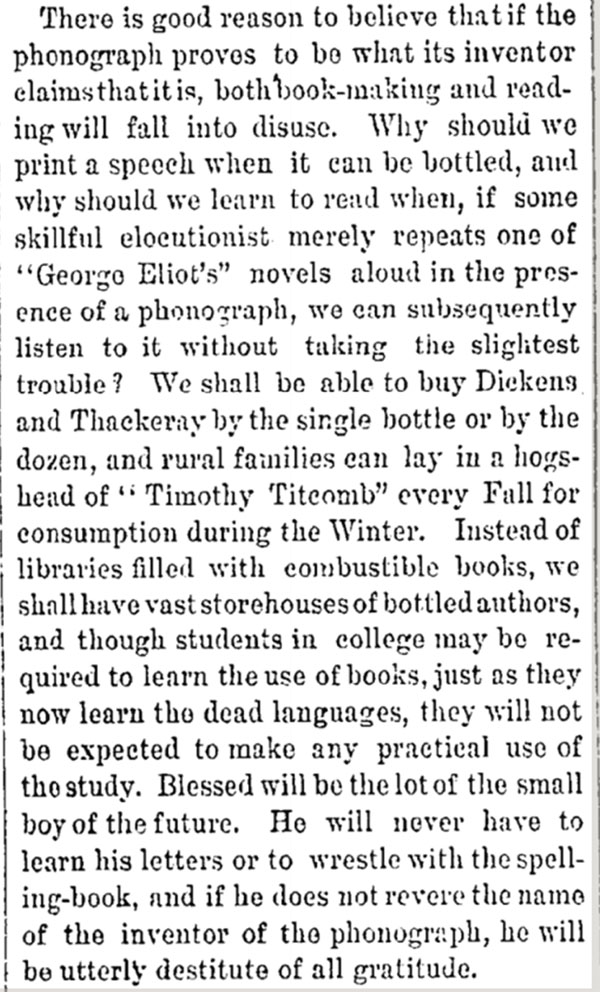
The New York Times
on November 7, 1877
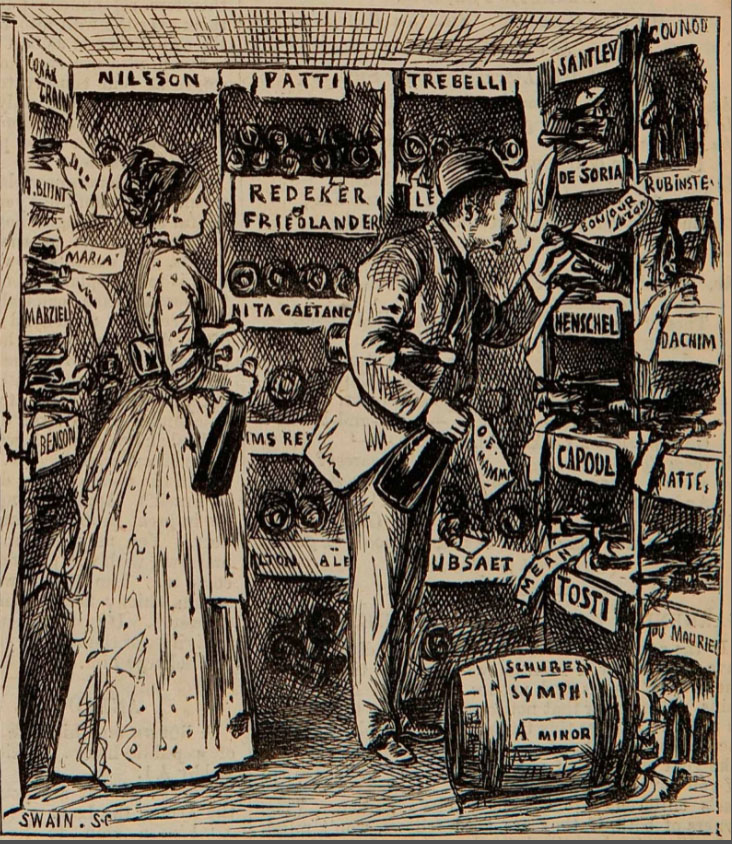
Besides bottling up authors and books
the phonograph would also be able to bottle up opera stars and music
as shown in this engraving from Punch’s Almanack for 1878,
December 14, 1877 (1)
"Bottled Music"
In The Phonoscope, January
1891, an article titled "Bottled Music" noted that the
U.S. Marine Band's music was "having its most harmonious
strains bottled in large quantities."
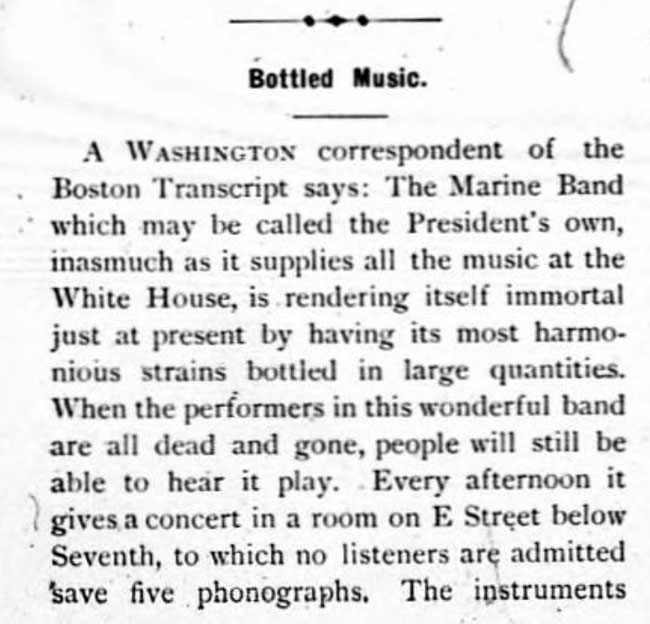
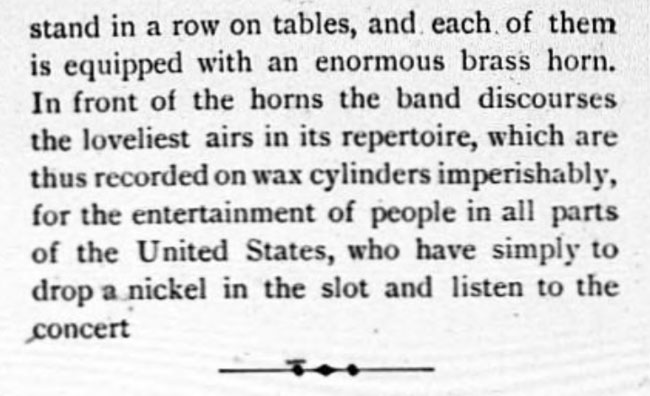
The Phonoscope,
January 1891
The Phonoscope,
February 1891, in an article titled "The Phonograph Album"
observed how a phonograph collection of recitations and popular
artists of the stage could allow its owner to give a "six-hours'
entertainment in his own house at any time, presenting the different
artists, whose voices he has "bottled up," so to speak,
in some of their most popular and successful roles."
"The Bettini device knows all
languages" Also, "bottled in the studio for future
uncorking is the music..."

The Phonoscope,
December 1899
Artists
Voices "Bottled Up"
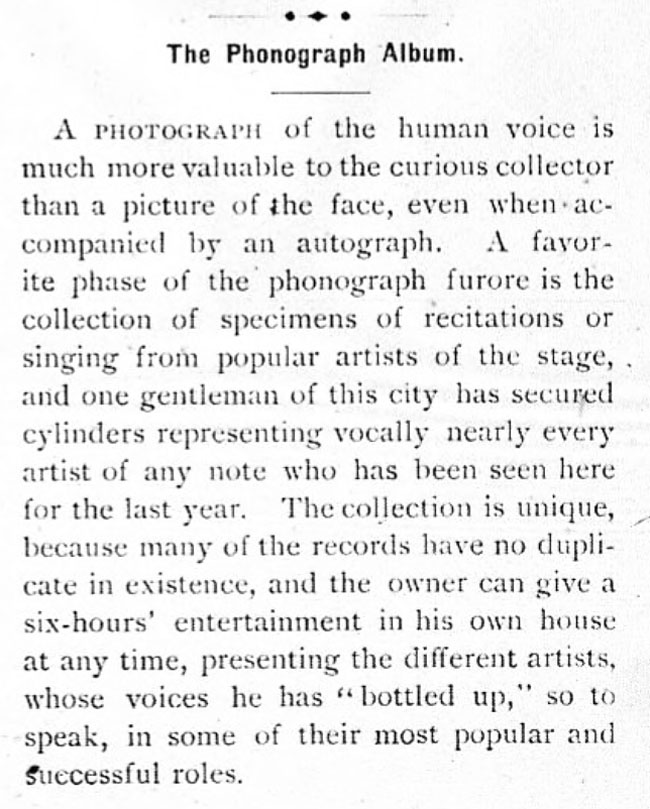
The Phonoscope,
February 1891
Although The New York Times
description of the phonograph being like wine bottled up for the
future was a clever metaphor, the article actually missed a fundamental
aspect of what the phonograph could do. It was stated that whatever
was "stored away in the cellar" could be brought out years
hence. But the Phonograph could do much more than simply store something
like a bottle of wine that could be drunk at a later time. What
was missing was the wonder that captured sound could be enjoyed
by anyone, anywhere and as often as they wanted -- and the fact
that the bottle would always remain full.
In keeping with this "bottling"
description for recorded sound John Philip Sousa would write some
disparaging remarks about recorded music using a different container
and calling it "canned music." Like a bottle, a can is
a container that can be filled with something and then emptied.
In his 1906 article in Appleton's Magazine titled "The
Menance of Mechanical Music" Sousa made his case against 'canned
music" which he feared was becoming a “substitute for human
skill, intelligence and soul.”
Canned music is "going
to ruin the artistic development of music in this country. When
I was a boy...in front of every house in the summer evenings, you
would find young people together singing the songs of the day or
old songs. Today you hear these infernal machines going night and
day. We will not have a vocal cord left. The vocal cord will be
eliminated by a process of evolution, as was the tail of man when
he came from the ape."
Circa 1904 Edison cylinder
record stored in cylinder box, similiar to an early 1900 can of baking
powder.
Some of Sousa's fears
about "canned music" illustrated
.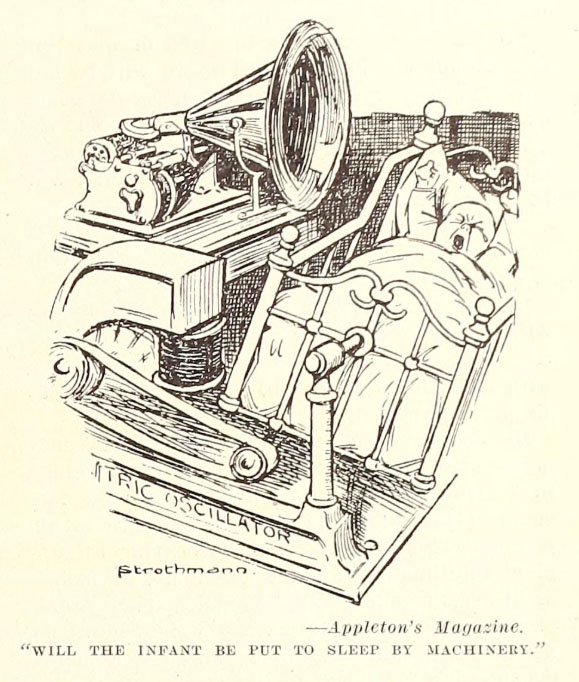
Appleton's
Magazine,
"The Menace of Mechanical Music" by John Philip Sousa, September
1906
Asked Sousa: "Shall
we not expect that when the nation once more sounds its call to
arms and the gallant regiment marches forth, there will be no majestic
drum major, no serried ranks of sonorous trombones, no glittering
array of brass, no rolling of drums? In their stead will be a huge
phonograph, mounted on a 100 H. P. automobile, grinding out "The
Girl I Left Behind Me," "Dixie," and "The Stars
and Stripes Forever."
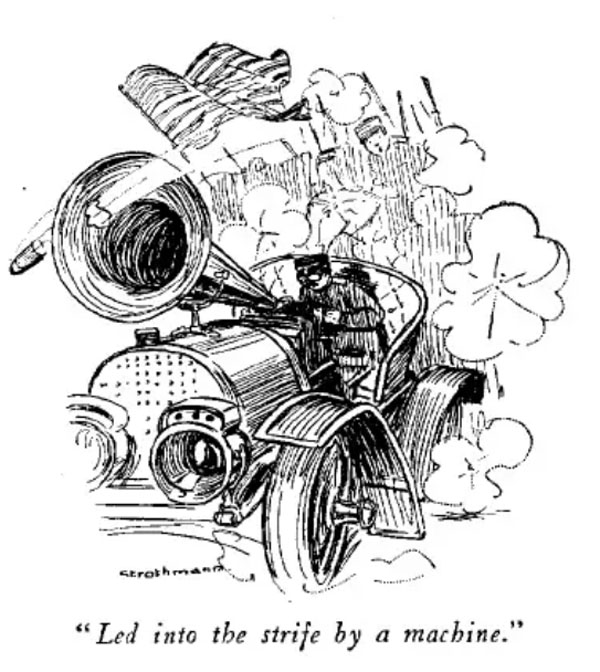
A 1906 Response to Sousa by the
New York Evening Post
'Canned music' is the epithet
applied by Mr. Sousa to the music made by phonographs and 'piano-players.'
He strongly objects to it on the ground that it tends to blunt
our national music sense. But it is a little difficult to see
what there is to blunt in the musical sense of a nation which
makes a hero of a Sousa, paying him $50,000 for a mediocre march
not worth $50. The phonographs help to make life more worth living
to farmers and villagers. They are not on a high aesthetic level,
but neither are the Sousa pieces, which are the favorites of the
phonograph audiences.
New York Evening Post, September
8, 1906
An advertising response
by Edison to Sousa's complaints about the phonograph and "canned
music."
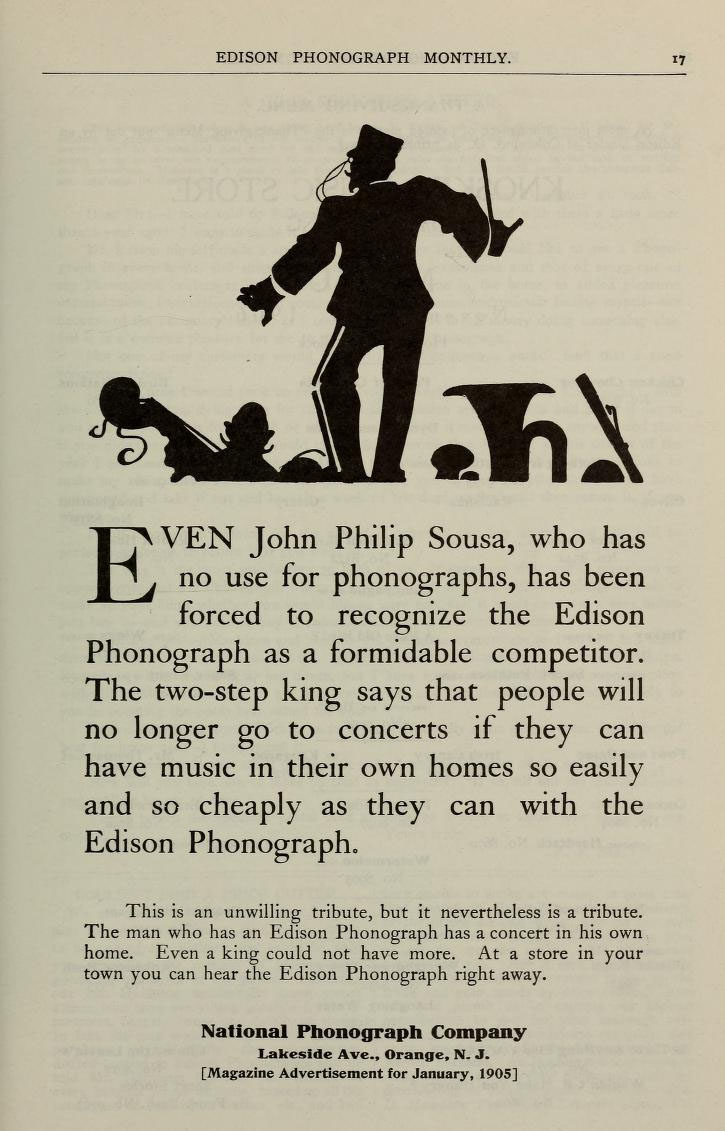
The Edison Phonograph
Monthly, January 1907
.
An earlier use of "canned
music" had appeared in O. Henry's 1904 story "The
Phonograph and the Graft." In addition to calling phonograph
music "canned" Henry also described the phonograph and its
records as "our galvanized prima donna and correct imitations
of Sousa's band excavating a march from a tin mine."
This Edison dealer postcard
advertising The New Edison (c. 1917) challenged previous generation
disparagements that talking machines play 'canned music." The
Edison did not play "canned music" - everyone who hears
the New Edison will delight in admiration, "just as they would
to the original music." (PM-0708)
"Canned Speech"
See Phonographia's Dictionary of
Phonographia for the definition of "Canned
Speech."
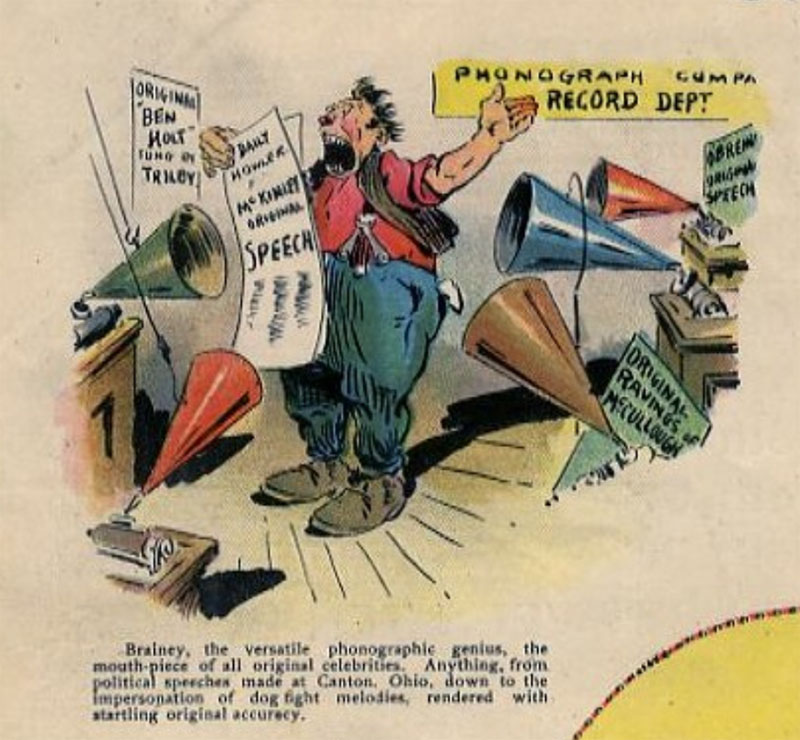
Celebrity and political impersonation
speeches (e.g., McKinley original Speech is what Brainey is currently
recording) Judge, June 1897 (PM-1825)
The "canned speech"
of President Wilson
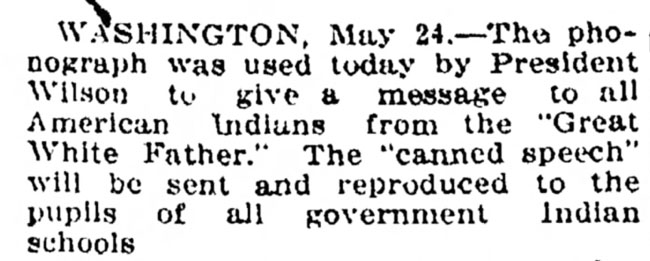
May 24, 1913, Lincoln
Daily News
"Canned Engagement
Annoucement"
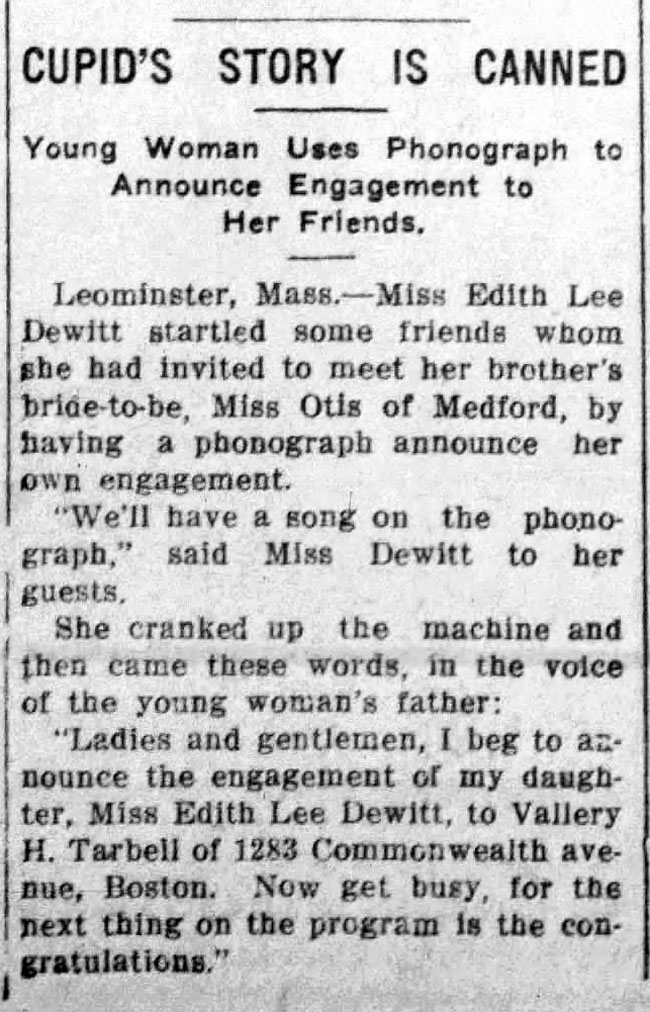
The Nebraska State Democrat,
May 16, 1912
"Imprison Sound"
Oakland Daily Evening Tribune,
May 1, 1878 reported that "It has been demonstrated beyond a doubt
that the phonograph, as perfected by Edson (sic), can imprison sound
and let it out at any future time."
Its summary for future use included the following: Testify in divorce
cases ("The phonograph won't lie."); send it to church on a rainy
Sunday to bring home the music and the sermon; repeat a good concert
at home. "But as a revealer of family secrets the phonograph may yet
lay the mischief. It will talk too much. The world has gained immensely,
because an infinite amount of mischievous talk has gone into oblivion.
But if hereafter, the phonograph is to be used as a repeater, a great
many lips would need to be toned to prudent speech."
"gathering up and
retaining of sounds..."
The opening paragraph of Edison's 1878
article, "The Phonograph and its Future" (The North American
Review May-June 1878), identified the foundation principle of
Edison's Phonograph as "the gathering up and retaining of sounds
hitherto fugitive, and their reproduction at will." This description
of sound as previously 'fugitive' is repeating the language of the
Oakland Tribune's pronouncement that sound can now be imprisoned.
The cultural change in the perception of sound and its preservation
was the revolution of the phonograph. Ephemeral sound would be forever
changed.
"capture the
fleeting beauties" of sound
This 1918 Victor advertisement dramatically
contrasts how the phonograph has changed music and the perception
of sound forever. On stage the ghost of Jenny Lind stands behind Melba
and the message of the ad is poignant and clear: "Jenny Lind
is only a memory but the voice of Melba can never die." Melba's
voice can be heard anytime, any place and as often as you want, flowing
forever "in centuries to come."
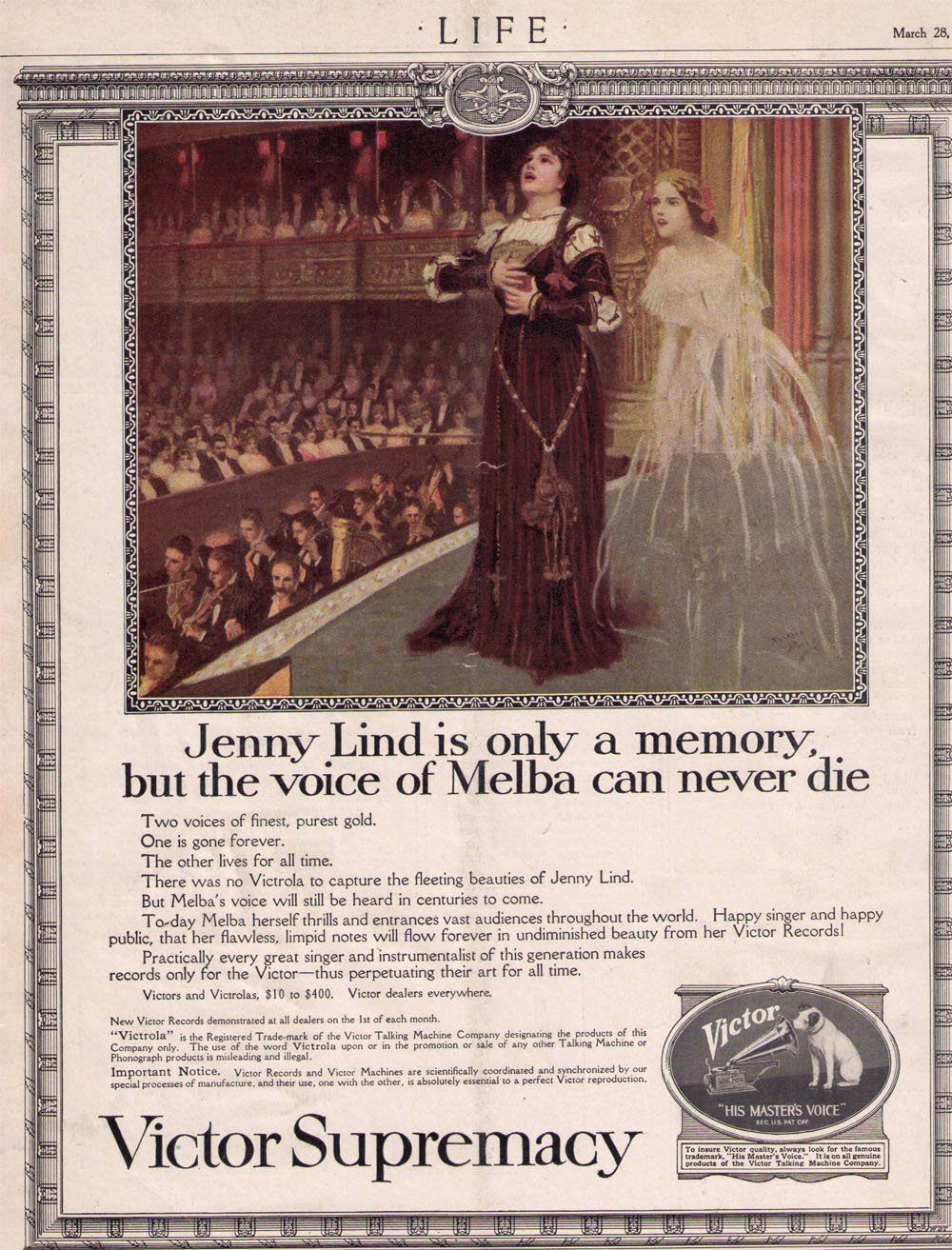
"Practically every great
singer and instrumentalist of this generation makes records only for
the Victor--thus perpetuating their art for all time. Life,
1918. (PM-2008)

Phonographia
|

